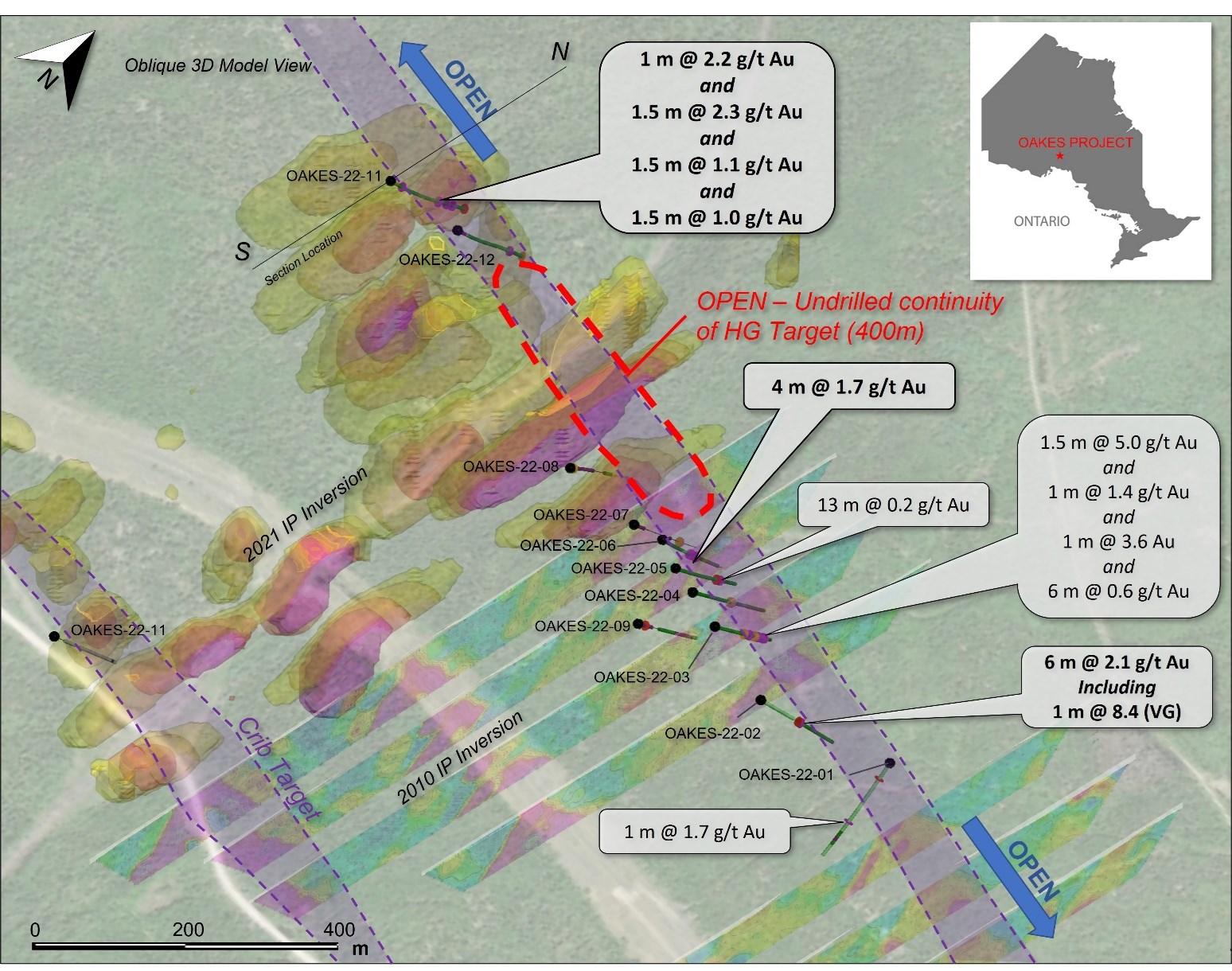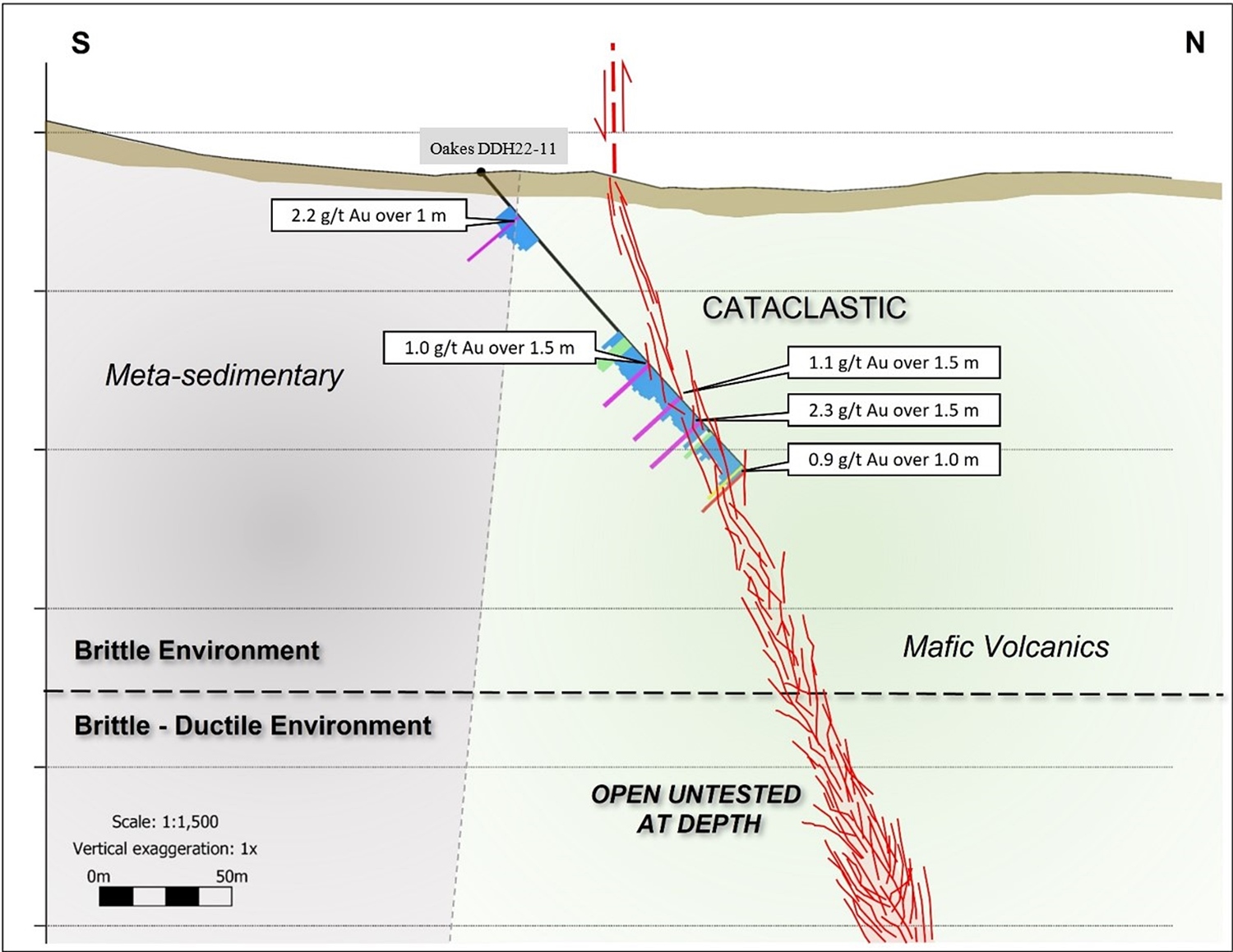2022 Drill Program
Riverside commenced its self-funded drill program at the Oakes Gold Project in March 2022. The primary focus of the first drill program at Oakes was to test the High Grade (“HG”) target identified by geophysics and trenching programs for gold grades and continuity.
The Induced Polarization (IP) work conducted by Riverside showed the HG IP target extended westward beyond the area of trenching and sampling. Drilling has now confirmed the gold continuity of over 1.2 kilometer along strike, and open in both east and west. The drill results announced in the most recent press release fit with the orogenic gold model and further drilling can be progressed with confidence. As all the holes of this program were shallow with intercepts generally less than 120m the system is considered open at depth.
This drill campaign has now successfully expanded the known gold mineralization well beyond the outcrops and laid the groundwork for the next drill campaign to continue expanding the Oakes gold camp. IP data provided strong conductivity and complimentary resistivity anomaly trending roughly east-west parallel to the geological units. The mineralized zone on surface is known to pinch and swell and averages about 4-5 m in width. The best hole in the second batch of reporting was DDH-22-06 which returned 1.7 g/t over 4 m with one sample being almost 5 g/t gold. The best intercept in the program was 8.4 g/t over 1 m in Hole #2.
Table 1: Spring 2022 Drill Program Highlights at Oakes (holes 1-12)
| HOLE# | FROM (m) | TO (m) | INTERVAL (m) | GOLD (g/t) |
| DDH2022-01 | 95 | 96 | 1 | 1.7 |
| DDH2022-02 including |
77 78 |
83 79 |
6 1 |
2.1 8.4 (VG) |
| DDH2022-03 | 73 | 74.5 | 1.5 | 4.0 |
| DDH2022-03 | 84 | 85 | 1 | 1.4 |
| DDH2022-03 | 105 | 106 | 1 | 3.6 |
| DDH2022-03 | 114.5 | 120.5 | 6 | 0.6 |
| DDH2022-04 | 83 | 96 | 13 | 0.2 |
| DDH2022-05 | 94 | 96.5 | 2.5 | 0.8 |
| DDH2022-05 | 102 | 103.5 | 1.5 | 1.5 |
| OAKES-22-06 | 72 | 76 | 4 | 1.7 |
| including | 72 | 73 | 1 | 4.9 |
| OAKES-22-06 | 85 | 88 | 3 | 1 |
| OAKES-22-07 | 98 | 100 | 2 | 0.9 |
| OAKES-22-08 | 9 | 10.5 | 1.5 | 0.4 |
| OAKES-22-09 | 18 | 18.5 | 0.5 | 1 |
| OAKES-22-11 | 22 | 23 | 1 | 2.2 |
| OAKES-22-11 | 96.5 | 98 | 1.5 | 1 |
| OAKES-22-11 | 113.5 | 115 | 1.5 | 1.1 |
| OAKES-22-11 | 125.5.5 | 127 | 1.5 | 2.3 |
| OAKES-22-11 | 151 | 152 | 1 | 0.9 |
| OAKES-22-12 | 106.5 | 108 | 1.5 | 2.4 |
| OAKES-22-12 | 130 | 131 | 1 | 0.4 |
Technical Interpretations & Observations:
Overall, mineralization increases with depth comprising pyrite-pyrrhotite up to 3% total sulfides. Semi-massive pyrite-pyrrhotite was noted in several holes and correlates to increased gold content. Visible gold was found in two holes associated with pyrite and lesser pyrrhotite in areas of quartz veining. The end of the zones is often marked by sections of millimeter-scale porphyroblastic garnets. At Holes -01, -07 and -08 gabbroic units mark the beginning of the mineralized zones. These geologic aspects will form the basis for developing the third dimension and understanding of the HG zone which continues to be progressing.
DDH-22-06 & 07 were designed to intercept the HG Zone beneath Trench 1 at about 100 m depth. The target zone comprises strongly foliated, fine grained, metavolcanic rocks showing strong silicified zones with narrow bleached sections. Alteration comprises abundant biotite and chlorite bands, the top of the unit shows quartz veining with semi-massive pyrite-pyrrhotite and trace chalcopyrite which generally described the mineralized environment at Oakes. Quartz carbonate veinlets and stringers are more frequent from 80 m to 110 m down the hole consistent with the drill target gold bearing area. The overall 25-30m mineralization halo and main zone which is near vertical, now demonstrates strong consistency and provides the Company confidence of a significant gold system at Oakes. DDH-22-08 hit a fault and could not reach the target. DDH-22-09 was the setback collared to drill the Brinklow IP anomaly south of HG Zone, while DDH-22-10 was collared on the Crib Road with the intent to test the IP anomaly associated with the metasediment/metavolcanic contact boundary mapped at this location. Holes 8, 9 and 10 were not intended to evaluate the HG target and were instead testing parallel features. Holes 6, 7, 11, 12 provide technical data specific to the HG trend and give positive results for further exploration at Oakes which lies 25 km east of the Hard Rock Mine.
 Figure 2: Drill Hole locations for the 12 holes drilled in 2022 plotted on IP Chargeability Map
Figure 2: Drill Hole locations for the 12 holes drilled in 2022 plotted on IP Chargeability Map
To view an enhanced version of this graphic, please visit: https://rivres.com/images/projects/canada/oakes_gold_project/DrillHole-locationfor-the12holes-drilled-in-2022_bigger.jpg
DDH-22-11 was targeting an IP conductivity anomaly associated with the HG Zone on trend with the mineralization defined on surface (and in drill core) at Hole 6 located 600 m to the east along what is believed to be the same structure. Assays returned gold results associated with veining throughout the hole and as high as 2.3 g/t gold. Hole 11 was collared in metasedimentary rocks and drilled northward into metavolcanic rocks. Bedding and the contact between the two units was measured at 50 degrees to the core axis whereas foliation and shearing is at about 45 degrees. Alteration comprises moderately to strong biotitic and weak to strong chlorite zones sometimes associated with carbonate zones. Quartz veining and silica content increases starting at 80 m downhole. Sulphides are associated with quartz veins and comprise 2-5% disseminated Pyrite-Pyrrhotite seen within local fracture fillings and stringers.
 Figure 3: Interpreted North - South Cross Section DDH-22-11 demonstrating the progression from brittle down into brittle-ductile deformation as the targeting model having found gold over 55m drill width zone in hole 11
Figure 3: Interpreted North - South Cross Section DDH-22-11 demonstrating the progression from brittle down into brittle-ductile deformation as the targeting model having found gold over 55m drill width zone in hole 11
To view an enhanced version of this graphic, please visit: https://rivres.com/images/projects/canada/oakes_gold_project/InterpretedNorth-SouthCrossSectionDDH-22-11_bigger.jpg
DDH-22-12 was collared in gabbro and drilled north through metasedimentary rock into metavolcanics. Mineralization is noted within similar altered rock but only within shears in the mafic volcanics and does not appear to be associated with the contact zones. Sheared zones commonly a focus for gold mineralization in orogenic systems like this one are expressed as altered, fine-grained, metavolcanics with moderate to strong chlorite-biotite alteration with quartz-carbonate veins and stringers with 1-2% disseminated pyrite and pyrrhotite.
Conclusions:
The HG Zone at Oakes has been proven to extend well beyond the strike extent defined by 2010 trenching and has now been drill proven to at least 1.1 km in length. To date the drilling has only tested the upper 100 m of the structure where gold mineralization is associated with quartz veins that are subparallel to foliation appear to be the veins that carry gold and are cut by later quartz carbonate veins that do not have sulfides. The quartz veins are mostly associated with brittle type fracturing with lesser semi-ductile type, potentially indicating that drilling was approaching the upper brittle-ductile transition which can be highly favorable in large orogenic gold deposits. The nature of the fracturing suggests that the shallow drilling is primarily within the upper brittle deformation zone as shown in Figure 2.
The Oakes property is located along the general metallogenic boundary of the Wabigoon and Quetico sub-provinces and this boundary is commonly a major fault breaks, and large gold resources are associated with these breaks generally in secondary shear zones in the Canadian shield geologic provinces. The Hemlo Gold Mine to the south is hosted in a brittle fracture environment and the Black Fox gold mine to the east in Matheson is hosted in a semi-ductile fracture system at depth and more brittle near the surface. Riverside sees the potential for brittle fracture zones progress into semi ductile and ductile zones at depth in general becoming wider and potentially richer as has commonly been found in the Wabigoon and Abitibi greenstone belts. These conclusions indicate more deeper drilling is warranted.
